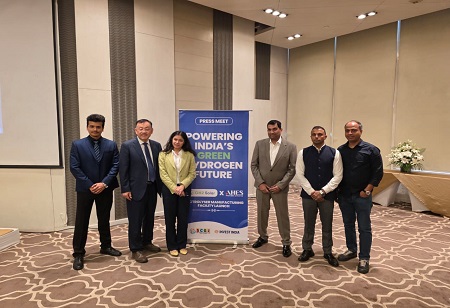
GH2 Solar Limited, is a next generation renewable energy company and one of only five companies in India Government’s PLI scheme for both green hydrogen production and electrolyser manufacturing.
It announced a major milestone under India’s Green Hydrogen Mission – its upcoming state-of-the-art Green Hydrogen Electrolyzer Manufacturing Facility in Gwalior, Madhya Pradesh, in joint venture with South Korea-based Advanced Hydrogen Energy Solutions (AHES) Ltd.
The facility located in Pipersewa, Morena district (Madhya Pradesh), will begin with an annual manufacturing capacity of 105 MW awarded under SECI’s SIGHT program, supported by ₹157.5 crore Production Linked Incentive (PLI) subsidy.
Also Read: Driving Digitalization in the Utility Industry
The total investment in the project is approximately ₹400 crore, with ₹100 crore allocated in the first phase to set up a 3 GWh BESS assembly line, and the remaining ₹300 crore to be invested in phases by 2030 to expand the facility. GH2 Solar has also outlined plans to expand the electrolyser capacity to 500 MW by 2030, directly contributing to the National Green Hydrogen Mission’s target of producing 5 million tonnes of green hydrogen annually by 2030.
The announcement was marked by a Bhoomi Pujan ceremony in Gwalior, graced by Shri Dr. Mohan Yadav, Hon’ble Chief Minister of Madhya Pradesh. The project was formally announced by Anuraj Jain, CEO and Founder of GH2 solar, alongside Prof. Joong-Hee Lee, CEO of AHES Ltd and Raj Sharma, Director of Rhizome Energy, UK, both key international partners of GH2 Solar’s green hydrogen journey.
Through the JV with AHES Ltd, GH2 Solar will bring advanced alkaline electrolyzer technology to India, with future expansion into PEM and other generation systems. In addition, GH2 Solar’s partnership with Rhizome Energy (UK) will embed sustainable design principles and advanced engineering practices, to ensure the facility is competitive, efficient and manufactures tailored solutions as per Indian conditions, strengthening the vision of making India a global hub for green hydrogen.
Speaking on the occasion, Mr. Anurag Jain, Founder and CEO, GH2 Solar, “As India advances towards energy independence and transitions from fossil fuels to green hydrogen, our Electrolyser Manufacturing Facility will play a critical role in this journey.
Also Read: Green Logistics: The Next Frontier in the Oil & Gas Sector
Through global partnerships, we are bringing cutting-edge decarbonization technologies, while government support enables us to effectively leverage local resources. We are also committed to collaborating with academic institutions and skill development centers to train engineers and technicians, ensuring India has a robust workforce to drive green hydrogen technologies forward.
Ultimately, our goal is to build a complete clean energy ecosystem that positions India as a leading producer and exporter of green hydrogen, with the workforce and technology to truly realize the vision of Atmanirbhar Bharat”
Adding to his perspective, Prof. Joong-Hee Lee, CEO of AHES, said, “The future is green, and no nation can achieve it alone. The world must unite in its commitment to sustainable energy. Our joint venture with GH2 Solar, brings this vision closer by producing electrolysers in India for the world.
India already has skilled manpower, strong public institutions, and crucial government policy and funding support. We are happy to contribute to this ecosystem and believe our Gwalior facility will be an important step in shaping the world’s green future.”
On the public institution side, the project is supported by Invest India and Skill Council for Green Jobs. The facility’s operations are expected to create over 300 direct jobs in manufacturing, operations and research, along with hundreds of secondary jobs across supply chain, logistics, and renewable energy services. By building renewable energy capabilities and training future workforce, the facility also makes a significant contribution to the Government of India’s Atmanirbhar Bharat Mission.
The project supports the Government of India’s National Green Hydrogen Mission, which targets 5 million metric tonnes of annual green hydrogen production by 2030 and underpins India’s ambition to achieve net zero by 2070. The Gwalior facility is expected to play a crucial role in decarbonizing high-emission sectors such as steel, fertilizers, and refineries, while also creating opportunities for export to Europe and East Asia.
We use cookies to ensure you get the best experience on our website. Read more...